FOOD FUN: Bundt Pans!
The first bundt pan arrived on the scene in 1949, and it’s been wowing folks every since. Did you know there are over 300 delicious ways to use your bundt pan? (I say YOUR bundt pan, because research says 9 out of 10 home cooks now own one.)
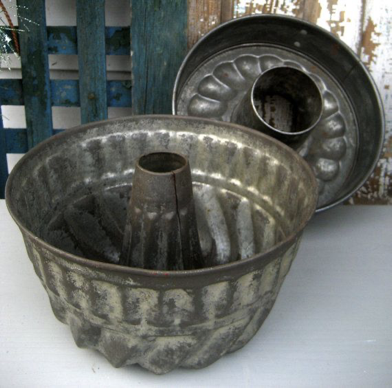
Anyway, that’s what the really interesting and inspiring book with the same title says. From desserts to "salads" (what Midwestern-ers call desserts) to entrees to regular salads, including pound cakes, fruitcakes, breads, cakes from mixes, coffee cakes, ice cream molds, cakes, and more—the recipes go on and on.
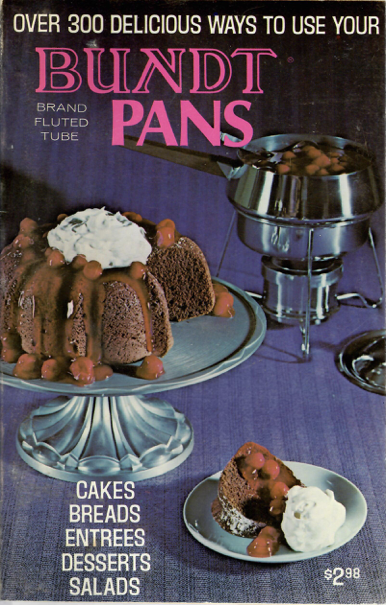
A bundt pan turns out a cake that isn’t like anything you can get from another pan. These pans are usually 10- or 12-inches in diameter and are up to 5 inches deep, with a hole in the center that ensures that the deep cake bakes evenly. Typically made from cast aluminum, the pan’s sides are almost vertical and have fluted or ridged designs that make the finished cake look very impressive.
Over the years, the pan style became so popular that manufacturers started to branch out into more creative designs, not limiting themselves to the traditional ridged round cakes. And you can also now find bundt pans in silicone and other non-stick materials, so they’re extra easy to use. And, they also come in several sizes, from 12-cup to mini.
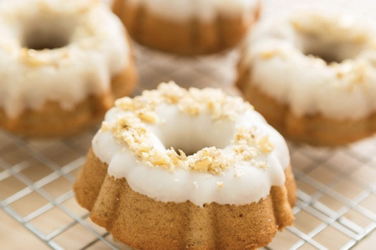
The bundt pan was originally used for pound cakes. Let me deviate for a second and talk about pound cakes:
But it can be a pain in the neck to grease, right? Well not anymore. Just go to https://www.kingarthurflour.com/blog/2017/01/22/prevent-bundt-cakes-sticking, to find excellent tips on how to easily, effectively grease your bundt pan. But here’s the short version:
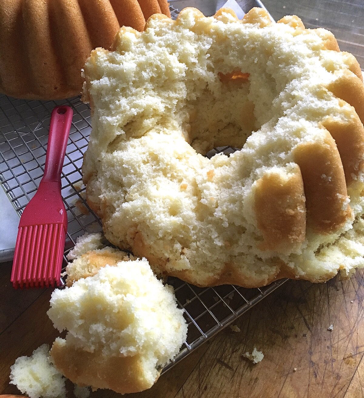
Use a non-stick pan — preferably one in good shape. An older non-stick pan with a scratched, worn non-stick surface may no longer be slick enough to release your cake flawlessly.
Grease the pan thoroughly using non-stick vegetable oil spray or melted shortening — not butter. The milk solids in butter can act like glue, encouraging cake batter to stick to the pan. (A pastry brush may be needed for this if your pan is intricate.)
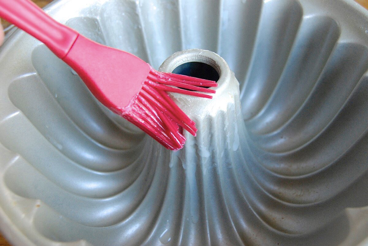
Grease the pan just prior to adding the batter. Greasing a non-stick Bundt pan too far ahead of time allows the oil to slide down the inside of the pan and pool in the bottom.
COAT, rather than flour your pan. If you're using a non-stick pan and still having trouble with your cake sticking, try sprinkling a coating of either finely ground nut flour (that's toasted almond flour on the left) or granulated sugar into the greased pan before adding the batter. Either will provide a barrier between batter and pan — which is what you're seeking.
Loosen the edges of the cake when removing from the oven. A bit of gentle poking with a table knife or thin heatproof spatula is that’s needed. Carefully slide the knife or spatula down the sides of the pan as far as you can, to release any sticking spots.
Don't forget the tube. Sometimes a cake can rise up and over the tube, effectively blocking it from releasing. Either cut away any extra cake that's encroached on the tube; or gently push it back with your fingers. You want the entire top surface of the tube to show.
Let the hot cake rest for a few minutes. Some cakes are extremely fragile right out of the oven; even if they don't stick to the pan, the simple act of moving them from pan to rack causes a fracture. So let your cake rest for about 5 minutes right side up; then for another 5 minutes upside down on a rack.
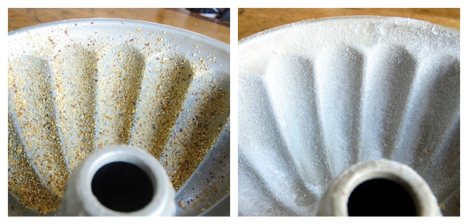
Give your Bundt a gentle nudge. If you've turned the pan over, waited, and the cake hasn't dropped out of the pan onto the rack, give it a few gentle side-to-side jiggles. This small motion is often enough to release it.
If all else fails, return your cake to the cooling (but still warm) oven for about 10 minutes. Often this mild heat is just enough to soften and release any baked-on areas clinging to the sides of the pan.
Now that we know how to successfully bake a bundt cake, how about we take another path? As the afore-mentioned recipe book says, it can be used for other things as well. I’ll close with a favorite family recipe that’s just awesome served with homemade crackers (or any good cracker, actually). Aunt Annie says she found this in the Better Homes and Gardens New Cookbook.
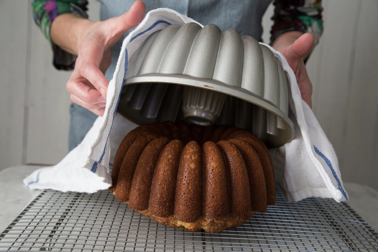
2 envelopes unflavored gelatin
1/2 cup cold water
1/2 can tomato soup (undiluted)
1/2 can any consomme
1/4 cup lemon juice
1 tablespoon mustard
1 teaspoon salt
1/2 teaspoon dried dill weed (fresh is what you’d go to in the summer)
1 cup mayonnaise
2 (6 1/2-ounce) cans tuna or 1 large can cooked salmon, drained and bones removed
1 cup chopped celery
1/2 cup thinly sliced cucumber
1/2 cup diced red bell pepper
Directions:
Add Recipe to Cook'n

Anyway, that’s what the really interesting and inspiring book with the same title says. From desserts to "salads" (what Midwestern-ers call desserts) to entrees to regular salads, including pound cakes, fruitcakes, breads, cakes from mixes, coffee cakes, ice cream molds, cakes, and more—the recipes go on and on.

A bundt pan turns out a cake that isn’t like anything you can get from another pan. These pans are usually 10- or 12-inches in diameter and are up to 5 inches deep, with a hole in the center that ensures that the deep cake bakes evenly. Typically made from cast aluminum, the pan’s sides are almost vertical and have fluted or ridged designs that make the finished cake look very impressive.
Over the years, the pan style became so popular that manufacturers started to branch out into more creative designs, not limiting themselves to the traditional ridged round cakes. And you can also now find bundt pans in silicone and other non-stick materials, so they’re extra easy to use. And, they also come in several sizes, from 12-cup to mini.

The bundt pan was originally used for pound cakes. Let me deviate for a second and talk about pound cakes:
- This cake gets its name from the fact that the ratio of ingredients is a pound of flour, a pound of butter, a pound of sugar, and a pound of eggs.
- The secret to obtaining a fine, rather compact pound cake grain is the creaming of the butter and sugar, the gradual adding and beating in of the eggs (which act as the liquid) and the careful folding in of the flour.
But it can be a pain in the neck to grease, right? Well not anymore. Just go to https://www.kingarthurflour.com/blog/2017/01/22/prevent-bundt-cakes-sticking, to find excellent tips on how to easily, effectively grease your bundt pan. But here’s the short version:

Use a non-stick pan — preferably one in good shape. An older non-stick pan with a scratched, worn non-stick surface may no longer be slick enough to release your cake flawlessly.
Grease the pan thoroughly using non-stick vegetable oil spray or melted shortening — not butter. The milk solids in butter can act like glue, encouraging cake batter to stick to the pan. (A pastry brush may be needed for this if your pan is intricate.)

Grease the pan just prior to adding the batter. Greasing a non-stick Bundt pan too far ahead of time allows the oil to slide down the inside of the pan and pool in the bottom.
COAT, rather than flour your pan. If you're using a non-stick pan and still having trouble with your cake sticking, try sprinkling a coating of either finely ground nut flour (that's toasted almond flour on the left) or granulated sugar into the greased pan before adding the batter. Either will provide a barrier between batter and pan — which is what you're seeking.
Loosen the edges of the cake when removing from the oven. A bit of gentle poking with a table knife or thin heatproof spatula is that’s needed. Carefully slide the knife or spatula down the sides of the pan as far as you can, to release any sticking spots.
Don't forget the tube. Sometimes a cake can rise up and over the tube, effectively blocking it from releasing. Either cut away any extra cake that's encroached on the tube; or gently push it back with your fingers. You want the entire top surface of the tube to show.
Let the hot cake rest for a few minutes. Some cakes are extremely fragile right out of the oven; even if they don't stick to the pan, the simple act of moving them from pan to rack causes a fracture. So let your cake rest for about 5 minutes right side up; then for another 5 minutes upside down on a rack.

Give your Bundt a gentle nudge. If you've turned the pan over, waited, and the cake hasn't dropped out of the pan onto the rack, give it a few gentle side-to-side jiggles. This small motion is often enough to release it.
If all else fails, return your cake to the cooling (but still warm) oven for about 10 minutes. Often this mild heat is just enough to soften and release any baked-on areas clinging to the sides of the pan.
Now that we know how to successfully bake a bundt cake, how about we take another path? As the afore-mentioned recipe book says, it can be used for other things as well. I’ll close with a favorite family recipe that’s just awesome served with homemade crackers (or any good cracker, actually). Aunt Annie says she found this in the Better Homes and Gardens New Cookbook.

Tuna Souffle Salad
Ingredients:
2 envelopes unflavored gelatin
1/2 cup cold water
1/2 can tomato soup (undiluted)
1/2 can any consomme
1/4 cup lemon juice
1 tablespoon mustard
1 teaspoon salt
1/2 teaspoon dried dill weed (fresh is what you’d go to in the summer)
1 cup mayonnaise
2 (6 1/2-ounce) cans tuna or 1 large can cooked salmon, drained and bones removed
1 cup chopped celery
1/2 cup thinly sliced cucumber
1/2 cup diced red bell pepper
Directions:
Soften gelatin in cold water. Heat soup and consommé to boiling and add gelatin mixture; stir to dissolve. Stir in lemon juice, mustard, salt and dill. Cool until slightly thickened. Whip and add mayonnaise. Fold in tuna and vegetables. Pour into bundt pan and chill until set. Unmold by dipping pan in warm water; invert onto your serving platter.
Recipe formatted with the Cook'n Recipe Software from DVO Enterprises.
Sources:
- www.pinterest.com
- www.amazon.com
- www.walnuts.org
- www.kingarthurflour.com/blog
- www.frydae.com
 Alice Osborne
Alice Osborne
Weekly Newsletter Contributor since 2006
Email the author! alice@dvo.com
